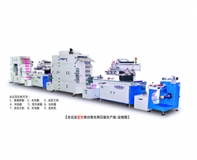Contact: Mr. Yang, 13925789871
Mr. Hu, 13509020493
Tel: 0769-82600378
Mailbox: imdiml@163.com
Company website: www.dglichao.cn
Address: No. 4, Hongye Middle Road, Yongtou, Chang'an Town, Dongguan, Guangdong, China
website:en.dglichao.cn

Contact: Mr. Yang, 13925789871
Mr. Hu, 13509020493
Tel: 0769-82600378
Mailbox: imdiml@163.com
Company website: www.dglichao.cn
Address: No. 4, Hongye Middle Road, Yongtou, Chang'an Town, Dongguan, Guangdong, China
website:en.dglichao.cn
Fully automatic screen printing machine screen type decontamination method
Fully automatic screen printing machine screen type decontamination method
We can't avoid the descreening of screen printing screens when using silk screen printing machine with automatic screen printing machine, but we often use automatic screen printing machine to screen different kinds of products and cause frequent on the screen. The dirt is not cleaned, resulting in waste, affecting the printing quality and shortening the service life of the stencil.
When there is dirt or dry ink on the printed part of the picture, the screen should be decontaminated, and the frame will be lifted after stopping the press. At this time, some operators will rub the solvent with abrasive cloth. The lower side of the stencil, the sound of the entire printing workshop can be heard, often the template is damaged.

When printing high-net-line color images, the emulsifier film under the wire is only 5-6um thick, and the mesh diameter of the mesh itself may be only 30um, which cannot be rubbed hard. Therefore, the key to avoiding rough decontamination is to prevent the stencil from being contaminated first.
The main cause of stencil contamination is improper ink control, which causes dry ink to remain in the mesh. When a solvent-based ink or an aqueous ink is used, the reason is that the ink is too thin or too thick. It should not change in the state of ink adjustment. When using UV-curable inks, efforts should be made to avoid exposure of the screen to UV light and to avoid exposure to sunlight.
Another problem with ink control and improper control of printing speed can result in uneven supply and rapid drying of the ink-receiving mesh.
The last cause of the drying of the ink is that the squeegee is improperly set or worn. When printing a fine image with a high number of screen lines, it is required to use the squeegee edge to deform or be worn during normal use. The sharpness of the image is reduced, which indicates that the ink may not pass through the mesh normally. If this problem is not solved in time, the ink will dry in the mesh. To avoid these problems, the squeegee should be flipped periodically to extend the life of its squeegee, or to switch to a new squeegee before the print quality has dropped.
In order for the mesh to function properly, care should also be taken to clean the dirt in the ink or on the substrate. Due to the electrostatic adsorption of pollutants in the air and poor storage conditions, the surface of the substrate may be contaminated. The above problems can be solved by improving storage conditions and process control. In addition, the destaticizer and the substrate decontamination device can be used. Prevent dust and dirt from transferring from the printing surface into the mesh.
What should I do if the template is contaminated? When using a flat screen printer, stop the printer after printing a set of sheets, and then input a piece of blotting paper to bring the screen into contact with the blotter.
Let the screen be in the printing position, then wipe off the dirt on the stencil surface with a non-abrasive soft cloth with a screen cleaner. Don't use too much force, so the dirt will fall through the mesh. On the absorbent paper below, if necessary, repeat the cleaning of the mesh with a piece of absorbent paper. Some of the dirt particles that fall on the top may be too large to pass through the mesh, but they can be glued with a soft cloth. After cleaning, the template can be blown dry with a blower (call "cold air").
When cleaning a circular screen printer, different situations are encountered. Due to the design structure, it is not possible to wash the dirt on the absorbent paper like a conventional screen printer. Fortunately, due to the faster printing speed, it is less likely that the ink will dry in the mesh. If this happens, first stop the press when printing the group, then use a non-abrasive soft cloth to apply the screen cleaner or thinner to the top of the template where the graphic is printed. The solvent scrubs the dirt in the mesh.
Sometimes the dirt under the template is removed. In this case, the dirt should be gently wiped off with a soft cloth. Do not use excessive force. The above cleaning and decontamination methods should be used frequently in the production process to extend the service life of the stencil and screen printing machine and reduce the scrap rate.
